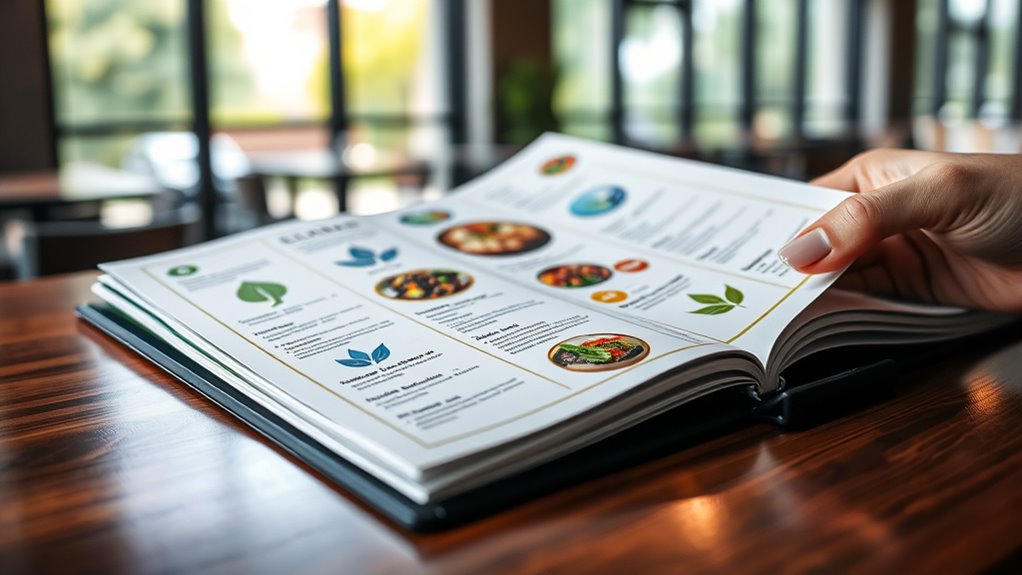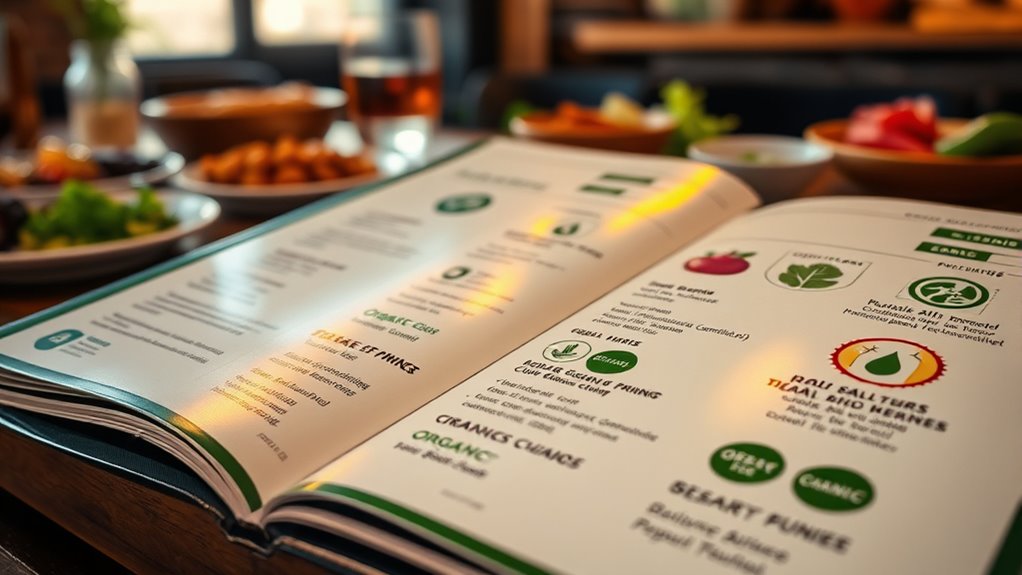Eco-labeling on menus influences how you perceive a restaurant’s commitment to sustainability. Clear labels can guide you toward eco-friendly choices, boosting your confidence in the restaurant’s practices. Most consumers trust straightforward, credible claims and appreciate transparency, which increases loyalty. However, skepticism exists if labels seem vague or inconsistent. Your response varies based on your preferences and background. To discover how restaurants can effectively communicate these benefits and build trust, explore further details below.
Key Takeaways
- Clear eco-labels on menus guide consumers toward sustainable choices and increase the likelihood of selecting eco-friendly dishes.
- Familiar and visually appealing labels enhance consumer trust and positively influence perceptions of restaurant sustainability efforts.
- Eco-label visibility and simplicity improve recognition, encouraging repeat visits and fostering brand loyalty.
- Demographic factors like age and income affect consumer responsiveness to eco-labels on menus.
- Effective communication, including brief descriptions and staff explanations, strengthens consumer understanding and confidence in eco-label claims.
The Rise of Eco-Labels in the Restaurant Industry

Eco-labels have gained momentum in the restaurant industry as consumers increasingly seek sustainable dining options. You’ll notice more restaurants displaying eco-labels on their menus, signaling their commitment to environmentally friendly practices. These labels often indicate responsible sourcing, waste reduction, or energy efficiency, helping you make informed choices. The rise of eco-labels reflects a growing awareness of environmental issues and a desire to support sustainable businesses. Restaurants see eco-labels as a way to differentiate themselves in a competitive market and appeal to eco-conscious diners like you. As awareness spreads, more establishments are adopting these labels to demonstrate transparency and build trust. This trend is transforming how restaurants communicate their sustainability efforts, making eco-friendly dining options more visible and accessible. Additionally, the use of AI analytics can help restaurants monitor and improve their sustainability practices more effectively.
How Consumers Perceive Sustainability Claims on Menus

Have you ever noticed how confidently restaurants highlight their sustainability claims on menus? You likely see labels like “locally sourced” or “eco-friendly” and assume they’re trustworthy. But how do you actually perceive these claims? A lot of consumers also rely on the perceived authenticity of these labels, similar to how Pimple Patches are trusted for targeted skincare. 1. Many consumers trust eco-labels, believing they indicate genuine environmental benefits. 2. Some become skeptical if claims seem vague or exaggerated. 3. Your perception often depends on how familiar you are with the label or certification. 4. You might prioritize sustainability claims more when dining at upscale restaurants or when you’re already environmentally conscious. Ultimately, your perception is shaped by trust, clarity, and personal values. Clear, credible claims tend to influence you positively, while ambiguous or unsubstantiated ones can lead you to doubt their authenticity.
Influence of Eco-Labels on Food Choices and Ordering Habits

Eco-labels on menus can considerably influence your food choices by highlighting sustainable options. When you see green labels, you’re more likely to select environmentally friendly dishes. This tendency shows that sustainability cues can directly shape your ordering habits and preferences.
Eco-Labels Drive Choices
When eco-labels are clearly displayed on menus, they can considerably influence your food choices and ordering habits. They serve as quick signals of sustainable options, guiding you toward more environmentally friendly decisions. Here’s how they impact you:
- You’re more likely to choose dishes with eco-labels, aligning your meal with your values.
- Eco-labels simplify decision-making by highlighting sustainable options, saving you time.
- They encourage you to try new menu items labeled as eco-friendly, broadening your choices.
- Seeing eco-labels can increase your overall awareness of sustainability, making you more conscious of your eating habits.
- The presence of eco-labels on menus can also promote sustainable packaging, further reducing environmental impact.
Green Options Increase
Seeing eco-labels on menus doesn’t just influence individual choices; it actively encourages you to pick more sustainable options. When you notice labels indicating environmentally friendly dishes, you’re more likely to contemplate those options over less sustainable ones. This visual cue makes eco-friendly choices more appealing and accessible, shifting your overall ordering habits. Restaurants with eco-labels tend to see an increase in the selection of green options, as diners feel guided toward sustainability without feeling pressured. The presence of these labels builds awareness and normalizes eco-conscious eating, leading to a broader acceptance of sustainable foods. Additionally, understanding Lifevest Advisors emphasizes the importance of responsible decision-making, which can extend to choosing environmentally friendly meals. Over time, this shift can profoundly boost the frequency with which eco-friendly dishes are ordered, fostering a more environmentally responsible dining culture.
Sustainability Influences Orders
Research shows that eco-labels on menus markedly influence your food choices, guiding you toward more sustainable options. When you see labels indicating environmental benefits, you’re more likely to select dishes that have a lower carbon footprint or use responsibly sourced ingredients. These labels can subtly steer your preferences and impact your ordering habits. For example:
- You may choose plant-based dishes over meat options due to eco-friendly labels.
- You might opt for locally sourced ingredients, reducing transportation emissions.
- You could avoid items with excessive packaging or waste.
- You may prioritize seasonal options that require fewer resources.
- Recognizing the importance of vibrational energy can help you align your choices with your desire for sustainability.
Factors That Enhance Trust in Eco-Label Claims

Trust in eco-label claims increases when you can verify the credibility of the labeling process. Transparency plays a vital role; when labels clearly communicate their standards, you’re more likely to trust them. Third-party certifications greatly boost confidence because independent organizations verify claims. Additionally, consistent messaging across menus, websites, and other platforms reinforces trust. Here’s a quick overview of factors that build trust:
| Factor | Description | Impact |
|---|---|---|
| Third-party Certification | Independent verification of eco-claims | Increases credibility and trust |
| Transparency | Clear info on standards and processes | Builds consumer confidence |
| Consistent Messaging | Uniform claims across platforms | Reinforces authenticity |
| Brand Reputation | Established eco-friendly track record | Enhances trustworthiness |
| Visible Certifications | Labels and seals displayed prominently | Provides immediate assurance |
Furthermore, aligning eco-labeling practices with mental wellbeing principles can foster greater consumer confidence, as people increasingly value transparency and authenticity in their choices.
Common Skepticisms and Challenges Faced by Eco-Labels

Despite the growing popularity of eco-labels, many consumers remain skeptical about their authenticity and effectiveness. You might wonder if these labels truly guarantee environmentally friendly practices or if they’re just marketing tools. Common challenges include:
- Lack of standardization—different labels may follow varying criteria, making it hard to compare.
- Greenwashing—some establishments exaggerate or falsely claim eco-friendly practices.
- Limited transparency—details about certification processes are often unclear or hard to access.
- Consumer fatigue—overexposure to labels can lead to distrust or indifference.
- The credibility of certifications is crucial for maintaining consumer trust and ensuring the labels reflect genuine sustainable efforts.
These issues make it difficult for you to trust eco-labels fully. As a result, you may question whether the labels genuinely reflect sustainable practices or are simply superficial marketing tactics.
The Role of Visual Cues and Design in Eco-Label Effectiveness

Visual cues and design elements play a crucial role in how effectively eco-labels communicate their message to consumers. Bright colors, clear symbols, and simple layouts grab attention quickly and convey eco-friendly qualities instantly. When eco-labels are visually appealing and easy to understand, you’re more likely to notice and trust them. Consistent use of familiar icons, like leaves or water drops, helps you recognize eco-friendly options at a glance. Conversely, cluttered or confusing labels can diminish credibility and reduce impact. Effective design guides your eye to key information without overwhelming you. You respond better to labels that are visually harmonious and straightforward, making it easier for you to incorporate sustainability into your choices effortlessly. Proper visual cues enhance trust and encourage eco-conscious decisions on menus. Additionally, understanding the importance of clear skincare application timing can improve your overall routine effectiveness when using targeted products.
Demographic Differences in Response to Eco-Labeling

Your response to eco-labeling can vary based on age, income, and cultural background. Younger and older consumers may value eco-friendly options differently, while income levels influence how much they prioritize sustainability. Cultural influences also shape how people interpret and respond to eco-labels on menus. Additionally, understanding consumer preferences for environmental features can help businesses better tailor their offerings to diverse audiences.
Age-Related Preferences
Have you ever wondered how different age groups respond to eco-labeling on menus? Younger consumers often see eco-labels as a reflection of their values, making them more likely to choose sustainable options. In contrast, older generations may prioritize taste or familiarity over eco-friendly labels. Here’s what influences their responses:
- Awareness levels – Younger people tend to be more informed about environmental issues.
- Value alignment – Older consumers might focus on personal benefits rather than ecological concerns.
- Trust in labels – Younger groups are more skeptical and seek transparency.
- Decision-making speed – Older individuals may take longer to decide, considering multiple factors beyond eco-labels.
- Product safety and adherence to standards, such as those outlined in Home Furnishings, can also impact consumer trust and decision-making.
Understanding these differences helps restaurants tailor messaging and improve eco-label effectiveness for each age group.
Income and Eco-Values
Why do income levels influence how people respond to eco-labeling on menus? Higher income individuals often have more disposable income and may prioritize sustainability as a value, making them more receptive to eco-labels. They tend to be more aware of environmental issues and willing to pay a premium for eco-friendly choices. Conversely, lower-income consumers might focus more on price and practicality, paying less attention to eco-labels unless the eco-friendly option also offers a tangible benefit or cost savings. Additionally, income can shape overall environmental awareness, with higher earners typically having greater access to information about sustainability. As a result, income levels create a significant divide in how consumers perceive and respond to eco-labeling on menus.
Cultural Influences on Choices
Cultural backgrounds greatly shape how people respond to eco-labeling on menus. Your cultural norms and values influence whether eco-friendly choices resonate with you. For example:
- In some cultures, environmental concerns are deeply rooted, making eco-labels highly effective.
- In others, traditional food preferences may override eco-conscious considerations.
- Cultural attitudes toward sustainability can affect trust in eco-labels and their perceived authenticity.
- Language and symbolism in labels might either clarify or confuse eco-friendly messages based on cultural context.
Understanding these differences helps you realize that eco-labeling’s impact isn’t universal. Your background can determine how motivated you are to choose eco-friendly options, making tailored communication essential for effective sustainable marketing.
Impact of Eco-Labels on Customer Loyalty and Brand Image

Eco-labels on menus can markedly influence customer loyalty and enhance brand image by signaling a restaurant’s commitment to sustainability. When you see eco-labels, you’re more likely to trust that the restaurant values environmental responsibility, which encourages repeat visits. Customers often associate eco-labeling with higher ethical standards, making them feel good about supporting such establishments. This positive perception strengthens your emotional connection to the brand, fostering loyalty over time. Additionally, eco-labels differentiate a restaurant from competitors, positioning it as progressive and environmentally conscious. As a result, your overall impression of the brand improves, leading to increased word-of-mouth referrals and positive reviews. In this way, eco-labeling not only attracts eco-minded diners but also cultivates a loyal customer base that values sustainability.
Strategies for Restaurants to Effectively Communicate Sustainability

To effectively communicate your sustainability efforts, you need clear labeling practices that are easy for customers to understand. Additionally, investing in staff education guarantees your team can confidently explain your eco-friendly initiatives. Together, these strategies help build trust and highlight your restaurant’s commitment to sustainability.
Clear Labeling Practices
How can restaurants effectively communicate their sustainability efforts through clear labeling? First, use straightforward language that avoids jargon, making labels easy to understand. Second, implement consistent symbols or icons across all menus to quickly convey eco-friendly attributes. Third, place labels near the dish name or description, ensuring visibility without cluttering the menu. Fourth, include brief, impactful descriptions that explain why a dish is sustainable, such as “Locally sourced” or “Responsible seafood.” These practices help customers easily identify sustainable options without confusion. Clear labeling builds trust and encourages eco-conscious choices. Remember, simplicity and consistency are key. Well-designed labels make sustainability efforts transparent and accessible, ultimately guiding customer decisions and reinforcing your restaurant’s commitment to environmental responsibility.
Staff Education Strategies
Effective staff education is key to ensuring your restaurant’s sustainability messages resonate with customers. When your team understands the importance of eco-labeling, they can confidently communicate it and answer questions. Start by providing extensive training sessions that cover the meaning behind each label, the benefits of sustainable sourcing, and how to highlight eco-friendly choices on the menu. Use clear, simple language and real-world examples to make the concepts relatable. Encourage staff to share their own enthusiasm for sustainability, which can influence customer perceptions. Regular refreshers keep knowledge current, and feedback sessions help identify gaps. Well-informed staff become ambassadors of your eco-conscious efforts, making your sustainability messaging authentic and compelling to diners.
Future Trends and Opportunities in Eco-Labeling Practices

As eco-labeling continues to gain traction, emerging trends reveal exciting opportunities for restaurants to enhance sustainability and attract environmentally conscious customers. You can leverage these trends to stand out and demonstrate genuine commitment.
- Digital Labeling: Incorporate eco-labels into digital menus and apps, making updates easy and engaging for customers.
- Blockchain Transparency: Use blockchain technology to verify and showcase supply chain sustainability, building trust.
- Integrated Sustainability Metrics: Offer real-time data on your restaurant’s environmental impact, encouraging responsible choices.
- Collaborative Certifications: Partner with recognized eco-label organizations to boost credibility and reach a wider audience.
Frequently Asked Questions
How Do Eco-Labels Influence Restaurant Pricing Strategies?
You might wonder how eco-labels impact restaurant pricing strategies. When eco-labels are added to menu items, you often see restaurants charging higher prices because they’re emphasizing sustainability and quality. This can attract eco-conscious customers willing to pay more. So, restaurants may use eco-labels as a way to justify premium pricing, positioning themselves as environmentally responsible and appealing to a specific market segment.
Are Eco-Labels Standardized Across Different Regions and Countries?
Think of eco-labels as international travelers—each with its own language and customs. Unfortunately, you’ll find that eco-label standards aren’t uniform across regions or countries. While some nations adopt rigorous, standardized eco-labeling schemes, others have more lenient or inconsistent criteria. This patchwork can make it tricky for you to compare sustainability claims globally, emphasizing the need for greater harmonization in eco-labeling practices to help you make informed, eco-friendly choices.
What Training Do Staff Need to Effectively Communicate Eco-Label Meanings?
You need to train staff to clearly understand eco-label meanings and their significance. Provide thorough education on sustainability standards, certification processes, and the environmental impact of labeled items. Teach them how to communicate this information confidently and simply to diners, emphasizing transparency. Role-playing scenarios can help staff practice explaining labels, ensuring they can answer questions accurately and promote eco-friendly choices effectively.
How Do Eco-Labels Impact Restaurant Operational Costs?
Eco-labels can influence your restaurant’s operational costs by requiring investment in staff training, sourcing sustainable ingredients, and updating menus. While initial expenses might rise, you can save money long-term through efficiencies and attracting eco-conscious customers. You’ll need to balance these costs with the benefits of sustainability. Overall, eco-labels encourage smarter resource use, which can lead to reduced waste and lower expenses over time.
Can Eco-Labeling Lead to Increased Customer Return Rates?
Think of eco-labeling as a beacon guiding eco-conscious customers back to your restaurant. When you clearly display sustainable practices, it builds trust and aligns with their values. This transparency can turn first-time visitors into loyal patrons, boosting return rates. By showing your commitment to the environment, you create a positive reputation that encourages repeat visits, making your restaurant a favorite spot for those who care about the planet.
Conclusion
By embracing eco-labeling, you can transform your menu into a beacon of sustainability, much like a lighthouse guiding eco-conscious customers. When you communicate genuine efforts and build trust, you not only influence food choices but also strengthen loyalty and brand reputation. Remember, skepticism is like fog that can obscure clear paths—address it transparently. Ultimately, eco-labels are a powerful tool to connect with your diners and foster a more sustainable dining experience.









